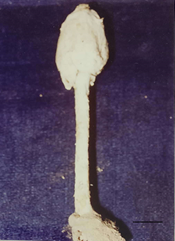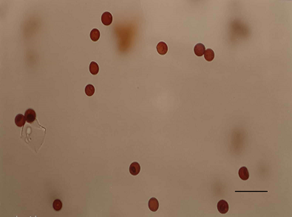Podaxis africana De Villiers, Eicker & Westhuizen S.Afr.J. Bot. 55(2): 160(1989) Fig. 4
MycoBank number: MB 125143; Index Fungorum number: IF 125143; Facesoffungi number: FoF 09748;
Fruiting body – stipitate,16.0 – 25.0 cm tall,dry,indehiscent at maturity.Stipe –cylindrical to subcylindrical or flattened, 8.0–9.5 × 0.7–2.0 cm, broad at the base to form a small bulb of intermingled sand and hyphae. Peridium – ellipsoidal, subcylindrical or nearly fusiform, 5.5–10.5 × 2.5–4.0 cm yellowish white with lower margin incurved at maturity and scaly. Exoperidium – creamish–white. Endoperidium – yellowish–brown, dehiscing longitudinally at maturity, more or less fragile when dry. Gleba– brownish-black. Spores – 6.0–6.5 ×7.0–7.5 µm fuscous black to umber, globose, subglobose to ovoid, with a short apiculus and prominent distal germ pore.
Ecology and distribution– De Villiers et al. (1989) reported Podaxis africana from termite heaps in South Africa. According to Conlon et al.(2016), it is unknown whether the termites feed on the fungus or that Podaxis uses the favourable conditions and concentrated nutrients within the nest to grow as a commensal without affecting the termites, or as a parasite growing inside the nest to the detriment of the colony.
Specimens examined – JNV/Mycl/162, 20 August 2018 in zone IA and IC on sand dunes by Reenu Chouhan. 25°45’0.00″N 71°22’48.00″E Barmer, elevation:227 m (745 ft),28°01’3.43″N 73°18’53.82″E Bikaner, elevation:242 m (794 ft), 26°55’3.47″N70°54’13.93″E Jaisalmer, elevation: 225 m (738 ft),28°18’0.00″N74°57’0.00″E Churu, elevation:292 m (958 ft).
Note – The description of the above genera resembles that of DeVilliers et al. (1989) from Africa in terms of the dimensions of the fruiting body, characteristics and colour of the endoperidium, exoperidium and spores. This was the first report of this species from India.

a

b
Fig. 4–a Fruiting body of Podaxis africana.b Spores.Scale bar: a = 5 cm,b = 20 µm.
